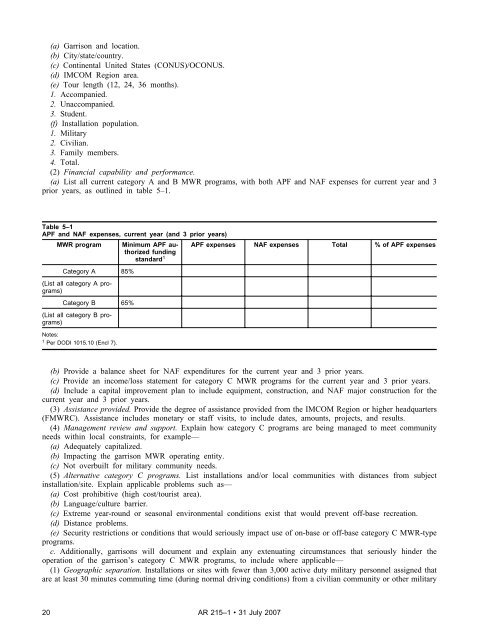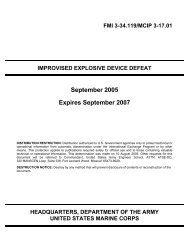AR 215-1 - Soldier Support Institute - U.S. Army
AR 215-1 - Soldier Support Institute - U.S. Army
AR 215-1 - Soldier Support Institute - U.S. Army
You also want an ePaper? Increase the reach of your titles
YUMPU automatically turns print PDFs into web optimized ePapers that Google loves.
(a) Garrison and location.<br />
(b) City/state/country.<br />
(c) Continental United States (CONUS)/OCONUS.<br />
(d) IMCOM Region area.<br />
(e) Tour length (12, 24, 36 months).<br />
1. Accompanied.<br />
2. Unaccompanied.<br />
3. Student.<br />
(f) Installation population.<br />
1. Military<br />
2. Civilian.<br />
3. Family members.<br />
4. Total.<br />
(2) Financial capability and performance.<br />
(a) List all current category A and B MWR programs, with both APF and NAF expenses for current year and 3<br />
prior years, as outlined in table 5–1.<br />
APF expenses NAF expenses Total % of APF expenses<br />
Table 5–1<br />
APF and NAF expenses, current year (and 3 prior years)<br />
MWR program Minimum APF authorized<br />
standard 1 funding<br />
Category A 85%<br />
(List all category A programs)<br />
Category B 65%<br />
(List all category B programs)<br />
Notes:<br />
1 Per DODI 1015.10 (Encl 7).<br />
(b) Provide a balance sheet for NAF expenditures for the current year and 3 prior years.<br />
(c) Provide an income/loss statement for category C MWR programs for the current year and 3 prior years.<br />
(d) Include a capital improvement plan to include equipment, construction, and NAF major construction for the<br />
current year and 3 prior years.<br />
(3) Assistance provided. Provide the degree of assistance provided from the IMCOM Region or higher headquarters<br />
(FMWRC). Assistance includes monetary or staff visits, to include dates, amounts, projects, and results.<br />
(4) Management review and support. Explain how category C programs are being managed to meet community<br />
needs within local constraints, for example—<br />
(a) Adequately capitalized.<br />
(b) Impacting the garrison MWR operating entity.<br />
(c) Not overbuilt for military community needs.<br />
(5) Alternative category C programs. List installations and/or local communities with distances from subject<br />
installation/site. Explain applicable problems such as—<br />
(a) Cost prohibitive (high cost/tourist area).<br />
(b) Language/culture barrier.<br />
(c) Extreme year-round or seasonal environmental conditions exist that would prevent off-base recreation.<br />
(d) Distance problems.<br />
(e) Security restrictions or conditions that would seriously impact use of on-base or off-base category C MWR-type<br />
programs.<br />
c. Additionally, garrisons will document and explain any extenuating circumstances that seriously hinder the<br />
operation of the garrison’s category C MWR programs, to include where applicable—<br />
(1) Geographic separation. Installations or sites with fewer than 3,000 active duty military personnel assigned that<br />
are at least 30 minutes commuting time (during normal driving conditions) from a civilian community or other military<br />
20 <strong>AR</strong> <strong>215</strong>–1 • 31 July 2007

















